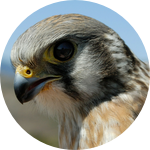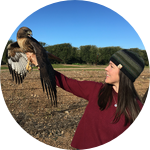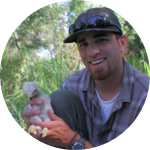About This Project
American Kestrels in the US have declined by 50% in the last 50 years and scientists are struggling to understand why. Increasingly kestrels are reliant on agricultural landscapes, yet little is known about how these landscapes affect their wintering diet. My study will be the first to comprehensively characterize the diet of wintering kestrels using novel genomic tools and will compare diet composition to crop type in order to provide data for both kestrel conservation and sustainable land use.
Ask the Scientists
Join The DiscussionWhat is the context of this research?
My study takes place in the Central Valley of California, which is critical to the production of agriculture in the United States and represents an ideal ecosystem in which to study the impacts of differing agricultural crops on the diet of wintering American Kestrels. Environmental DNA (eDNA) metabarcoding is a genomic technique that uses trace amounts of DNA to get a snapshot of the organisms present in a sample collected in a given environment. I will use this technology to characterize the diet of wintering American Kestrels by swabbing their beaks to gather microscopic remains from their previous meals. I will combine the dietary data with agricultural crop type data gathered from GIS to further elucidate the relationship between kestrel diet and human land-use.
What is the significance of this project?
We face a crisis in the loss of global biodiversity, including many avian species which play important roles in ecosystem function. Birds are indicator species of the overall health of our environment and their declines often indicate the failure of human altered landscapes to adequately support biodiversity. Agricultural landscapes increasingly represent the largest habitat available for many avian species in the United States and around the world. Kestrels in particular, are increasingly dependent on agricultural lands and it is important to determine how agricultural practices influence prey selection. This study will provide key insights into the diet of North America’s smallest falcon and inform full-life-cycle informed management strategies in agricultural practices.
What are the goals of the project?
1) Characterize the diet of American Kestrels that utilize the agricultural landscapes of the Central Valley of California as critical wintering grounds.
I will collect eDNA samples by swabbing the beaks of American Kestrels. Using DNA metabarcoding I will identity prey present in the samples (mammals, birds, reptiles, insects).
2) Investigate the relationship between agricultural crop cover and the American Kestrel diet to further understand how human land-use affects kestrel survival.
I will use Arc GIS to characterize information about crop type (orchard, row, and forage) at the location of of each eDNA sample taken and compare that to the prey species detected at each site.
Budget
The proposed budget will allow me to complete the lab work necessary to achieve my project goals- from performing the DNA extractions to purchasing the lab supplies necessary to prepare and submit my samples for sequencing.
For DNA extraction, the process that purifies the DNA from the swabs, I will purchase the QIAamp DNA mini kit.
For library preparation, the molecular lab work needed to submit samples for sequencing, I will buy the reagents and primers necessary for PCR amplification and purification. My study will use a combination of vertebrate and insect primers in order to detect the variety of prey species that are possible in the kestrel diet. Kestrels are ferocious hunters and eat a mix of small mammals, birds, reptiles and insects and having a mix of primers will allow my study to capture the breadth of their diet.
The budget will allow me to sequence my samples on a Miseq sequencer, a platform that is commonly used in metabarcoding studies.
Endorsed by
 Project Timeline
Project Timeline
This winter, I am collecting 50 eDNA samples from kestrels in California's Central Valley. I will then extract the eDNA and perform PCR amplification and purification steps to prepare the samples for DNA sequencing. I will then submit my library to the UC Davis Genome Center to be sequenced. Lastly, I will use a bioinformatics pipeline and identify sequenced DNA, which will allow me to describe the unique prey items each kestrel consumed and compare that to the type of crop in which they hunt.
Feb 02, 2022
Project Launched
Mar 01, 2022
Finish collecting eDNA samples from wintering kestrels
Mar 01, 2022
Start lab work, beginning with DNA extractions
Jun 01, 2022
DNA metabarcoding library preparation
Aug 01, 2022
Submit DNA metabarcoding library for sequencing
Meet the Team
Mary Badger
I am interested in using novel genomic tools to further species conservation research. For the past two years, I have worked as a lab technician at the Genomic Variation Laboratory at UC Davis on the conservation of endangered native fish species, such as the Delta smelt and the Paiute Cutthroat trout, using genomic techniques. This coming fall, I am excited to be joining the Hull Lab at UC Davis, a lab that focuses on raptor conservation. For my Master’s research, I will have the opportunity to lead my first study investigating the diet of American Kestrels using genomic techniques. Other research experience I have includes using genomic techniques to track the invasion of the non-native European green crab in Maine, monitoring Piping Plovers and Least Terns with Maine Audubon, and authoring a paper on the spatial distribution of marine ciliates in tide pools. I am thrilled to be able to continue using molecular techniques to provide rapid and noninvasive monitoring of wild populations at UC Davis as a Master’s student.
Project Backers
- 23Backers
- 116%Funded
- $4,655Total Donations
- $202.39Average Donation



